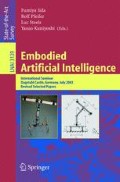Abstract
We propose to investigate the foundations of communication and symbolic behavior by means or a robotics approach, i.e. by studying how these behaviors might emerge from the physical dynamics of an agent and its sensory-motor interactions with the real world. In this perspective, the human-robot interface problem can be viewed as one of coupling the interaction dynamics of all agents. Through a number of case studies we will show that within this interaction dynamics there is sparse global structure, i.e. a structure that can be characterized by only a small number of points in phase space, and that it is best to interact with the agent, i.e. interfere with its dynamics, at these points. We introduce a humanoid robot with the capability for dynamic full-body movement. The preliminary results of two experiments, sitting and standing up, are presented. Lastly, experiments with self exploratory learning of embodiment and visual motor learning of neonatal imitation abilities are introduced.
Access this chapter
Tax calculation will be finalised at checkout
Purchases are for personal use only
Preview
Unable to display preview. Download preview PDF.
References
Kuniyoshi, Y., Nagakubo, A.: Humanoid as a research vehicle into flexible complex interaction. In: Proc. IEEE Int. Conf. Intelligent Robots and Systems, pp. 811–819 (1997)
Kuniyoshi, Y., Inaba, M., Inoue, H.: Learning by watching: Extracting reusable task knowledge from visual observation of human performance. IEEE Trans. Robotics and Automation 10 (1994)
Kuniyoshi, Y., Inoue, H.: Qualitative recognition of ongoing human action sequences. In: Proc. International Joint Conf. on Artificial Intelligence, pp. 1600–1609. Morgan Kaufmann, San Francisco (1993)
Newtson, D., et al.: The objective basis of behavior units. J. of Personality and Social Psychology 35, 847–862 (1977)
Yamamoto, T., Kuniyoshi, Y.: Stability and controllability in a rising motion: a global dynamics approach. In: Proceedings of the International Conference on Intelligent Robots and Systems, pp. 2467–2472 (2002)
Taga, G., Yamaguchi, Y., Shimizu, H.: Self-organized control of bipedal locomotion in unpredictable environment. Biol. Cybern. 65, 147–159 (1991)
Rizzi, A.A., Koditschek, D.E.: Further progress in robot juggling: The spatial two-juggle. In: Proc. IEEE Int. Conf. Robotics and Automation, pp. 919–924 (1993)
Miyakoshi, S., Taga, G., Kuniyoshi, Y., Nagakubo, A.: Three dimensional bipedal stepping motion using neural oscillators – towards humanoid motion in the real world. In: Proc. IEEE Int. Conf. Intelligent Robots and Systems (1998)
Kuniyoshi, Y., Nagakubo, A.: Humanoid Interaction Approach: Exploring Meaningful Order in Complex Interactions. In: Proceedings of the International Conference on Complex Systems (1997)
Kuniyoshi, Y., Nagakubo, A.: Humanoid As a Research Vehicle Into Flexible Complex Interaction. In: Proceedings of IEEE/RSJ International Conference on Intelligent Robots and Systems, IROS 1997 (1997)
Raibert, M.H.: Legged Robots That Balance. The MIT Press, Cambridge (1986)
Pfeifer, R., Bongard, J., Iida, F.: New robotics: design principles for intelligent systems. Artificial Life (2004)
Nagakubo, A., Kuniyoshi, Y., Cheng, G.: Development of a High-Performance Upper-Body Humanoid System. In: Proceedings of IEEE/RSJ International Conference on Intelligent Robots and Systems, IROS 2000 (2000)
Cheng, G., Kuniyoshi, Y.: Complex continuous meaningful humanoid interaction: A multi sensory-cue based approach. In: Proceedings of IEEE International Conference on Robotics and Automation, San Francisco, U.S.A (2000) (to appear)
Morita, M.: Memory and learning of sequential patterns by nonmonotone neural networks. Neural Networks 9, 1477–1489 (1996)
Piaget, J.: Play, Dreams and Imitation in Childhood. W. W. Norton, New York (1962)
Meltzoff, A.N., Moore, M.K.: Imitation of facial and manual gestures by human neonates. Science 198, 75–78 (1977)
Kuniyoshi, Y., Yorozu, Y., Inaba, M., Inoue, H.: From visuo-motor self learning to early imitation – a neural architecture for humanoid learning. In: Proc. IEEE Int. Conf. on Robotics and Automation, pp. 3132–3139 (2003)
Sato, T., Hirai, S.: Language-aided robotic teleoperation system (larts) for advanced teleoperation. IEEE J. Robotics and Automation 3, 476–481 (1987)
Lee, S.: Intelligent sensing and control for advanced teleoperation. IEEE Control Systems Magazine 13, 19–28 (1993)
Brunner, B., Arbter, K., Hirzinger, G.: Task directed programming of sensor based robots. In: Proc. IEEE/RSJ/GI Int. Conf. Intelligent Robots and Systems (IROS), pp. 1080–1087 (1994)
Asao, T.: From Gestures to Language. Shin’yosha (1992)( in Japanese)
Kuniyoshi, Y.: Behavior matching by observation for multi-robot cooperation. In: Giralt, G., Hirzinger, G. (eds.) Robotics Research – The Seventh International Symposium., pp. 343–352. Springer, Heidelberg (1996)
Author information
Authors and Affiliations
Editor information
Editors and Affiliations
Rights and permissions
Copyright information
© 2004 Springer-Verlag Berlin Heidelberg
About this chapter
Cite this chapter
Kuniyoshi, Y. et al. (2004). From Humanoid Embodiment to Theory of Mind. In: Iida, F., Pfeifer, R., Steels, L., Kuniyoshi, Y. (eds) Embodied Artificial Intelligence. Lecture Notes in Computer Science(), vol 3139. Springer, Berlin, Heidelberg. https://doi.org/10.1007/978-3-540-27833-7_15
Download citation
DOI: https://doi.org/10.1007/978-3-540-27833-7_15
Publisher Name: Springer, Berlin, Heidelberg
Print ISBN: 978-3-540-22484-6
Online ISBN: 978-3-540-27833-7
eBook Packages: Springer Book Archive

